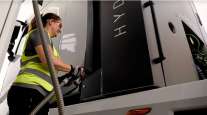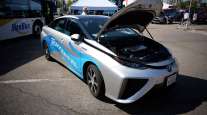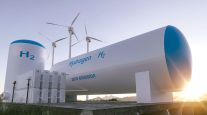Commercial Hydrogen Fueling Station to Open in California
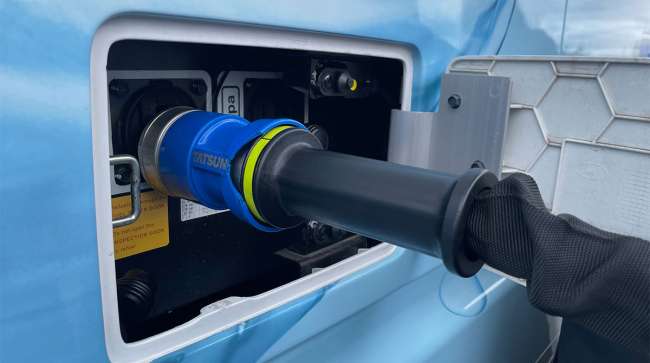
[Stay on top of transportation news: Get TTNews in your inbox.]
OAKLAND, Calif. — FirstElement Fuel will open what it is calling the world’s first heavy-duty high-flow hydrogen fueling facility to the public in May. The station is the first of about a dozen commercial hydrogen truck fueling locations the company has planned.
“This is the first time that there is truly a commercially available hydrogen station,” said Ghassan Sleiman, chief technology officer for FirstElement Fuel.
The station dispenses liquid hydrogen using FEF’s proprietary technology, providing 700 bar — equivalent to more than 10,000 psi — fast fills. “It is distributed to this station as liquid, and we use a cryopump to convert it,” said Shane Stephens, the company’s chief development officer.
The location features four light/medium-duty dispensers and two heavy-duty truck pumps and can fuel 200 trucks a day in under 10 minutes each. “This is 10 times higher capacity than any hydrogen station deployed anywhere in the world before,” Stephens said. “We can do fast fuels with simultaneous truck refueling back-to-back all day long.”
Two contract customers are currently refueling at the location, and FEF has completed more than 200 demonstration fills on heavy-duty trucks, most of those with Hyundai Motor North America. Stephens said the exact date in May the facility will open to the public depends on final inspections.
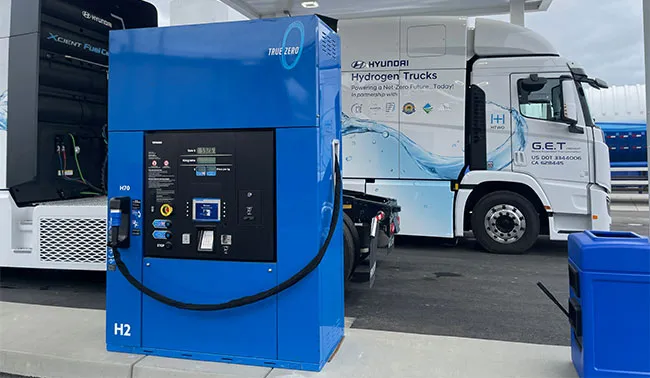
Hyundai is operating 30 Xcient Fuel Cell trucks in drayage operations with Global Expedited Freight at the Port of Oakland and fueling at the FirstElement Fueling heavy-duty commercial station. (Mindy Long for Transport Topics)
“This station represents a belief in a better future. It represents what we can do to have industry function without compromising health,” said Tyson Eckerle, senior adviser for clean infrastructure and mobility in the California Governor’s Office of Business and Economic Development.
Eckerle, along with several other industry representatives, spoke during an event celebrating the new facility.
As part of FEF’s Oakland project, Hyundai deployed 30 Xcient Fuel Cell trucks in drayage operations with Global Expedited Freight. It takes about 60 kilograms of hydrogen to fuel each truck.
“We should be able to eliminate 50 million pounds of CO2 and replace almost 2 million gallons of diesel being used. This is only from 30 trucks. Now magnify that by 1,000 trucks,” said Eugene Litvinov, Hyundai Motor North America director of commercial vehicle and hydrogen business development.
Litvinov stressed “this is just a down payment” on what Hyundai can do more of in the future. “This project shows we believe that hydrogen is going to play a critical role because of its high energy density,” he said, noting that the company will deploy 100 trucks near its Metaplant in Savannah, Ga., and has hydrogen trucks operating globally, including in Switzerland, Germany, New Zealand and South Korea.
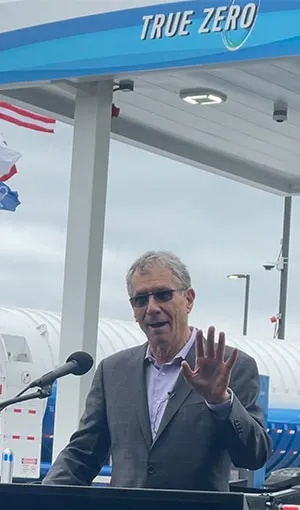
Jaimie Levin, senior program manager and director of the West Coast office at the Center for Transportation and the Environment, said the ARCHES program is committed to a 100% renewable grid by 2045. (Mindy Long for Transport Topics)
Jaimie Levin, senior program manager and director of the West Coast office at the Center for Transportation and the Environment, said the ultimate goal is not just the 30 trucks in the project “but the thousands of trucks that are lined up here daily moving freight out of this [Oakland] port and the other ports.”
Nikola has entered into a 10-year agreement to fuel its hydrogen fuel cell electric trucks at the Oakland location, appointing FEF as an authorized Nikola Fueling Solutions Partner.
Nikola is also developing hydrogen fueling stations through its Hyla brand. However, Ole Hoefelmann, president of the Nikola energy division, told Transport Topics the company is trying to build a network with partners and not be exclusive. “We don’t need to build all permanent markets ourselves,” he said, adding that Nikola has just over 70 hydrogen trucks on the road today.
David Hull, regional vice president of Bosch Rexroth, said the prospect of making fuel from water has long been a possibility, but the economics haven’t worked in the past. “Every time oil went way high, people would get interested, and then oil drops and, commercially, it ends. It is different today,” he said.
For one thing, there is more political will to adopt alternative fuels as government mandates are pushing fleets to find new solutions. Plus, technology is advancing. “There is momentum behind this,” Hull said.
Matt Miyasato, chief public policy and programs officer for FEF, said California regulations in 2036 will require every truck and vehicle sold in the state to be zero emission. “We believe a good portion of those will be hydrogen fueled,” he said.
Litvinov said hydrogen Class 8 tractors provide advantages over battery-electric vehicles for longhaul applications, including a lower weight, which doesn’t inhibit payload, and a longer driving range of about 450 miles. “They don’t have cold weather issues and place no additional electrical stress on the power grid,” he said.
Check out Transport Topics' updated Top 100 list of the largest logistics companies in North America, and explore how the industry's top players have adapted to a tough freight market and are preparing for the future. Tune in above or by going to RoadSigns.ttnews.com.
Charging infrastructure for heavy-duty applications also remains a challenge, said Jerome Gregeois, director of commercial vehicle development at Hyundai Kia America Technical Center. “If you charged 50 Class 8 trucks, it would take nine megawatts. That is equivalent of powering the Empire State Building,” he said. “It might not be feasible for the utility [company].”
Hydrogen also creates a fueling experience for drivers similar to diesel. “The driver doesn’t have to do anything out of the norm like they would with batteries,” Stephens said. “The driver swipes his card, connects the nozzle to his truck and is on the road.”
Quintin Steen, a driver for Global Expedited Freight, has been driving an Xcient truck at the port for the past six months. “It is a very simple fueling process for us,” he said, adding that he likes how quiet the truck is from inside the cab.
FEF hasn’t set a public price at the dispenser yet but will offer a lower price for customers with contracts, Stephens explained. He acknowledged that at the outset the cost per mile will probably be double what it is for diesel. “We realize with trucking, it is a pennies business, and we are working to get those numbers down,” he added.
One key to driving down costs is increasing the availability of fueling infrastructure, which Stephens called “the last remaining challenge for hydrogen.” FEF currently has 41 retail station locations in California and expects to open 12 to 15 heavy-duty fueling stations in the state in the next five to seven years. FEF could also work with centrally fueled fleets to provide private fueling setups.
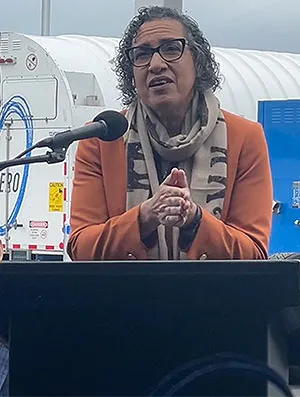
Liane Randolph, chair of the California Air Resources Board, said California's Advanced Clean Truck and Advanced Clean Fleet rules will require more zero-emission vehicles, such as hydrogen fuel cells. (Mindy Long for Transport Topics)
Liane Randolph, chair of the California Air Resources Board, praised FEF and its partners. “All of that working together is what will protect the public health of residents here in Oakland. It has a global impact and a local impact,” she said.
According to Randolph, CARB has sought strategies that are sustainable and effective from a regulatory and industry standpoint. “We’re seeing there is a lot more communication between goods movements, warehouses and trucking companies to build that ecosystem. For a few years it will take that kind of coordination,” she said.
FEF is also a Tier 1 Partner in California’s Hydrogen Hub initiative called ARCHES (Alliance for Renewable Clean Hydrogen Energy Systems). That program was selected for a $1.2 billion award from the U.S. Department of Energy.
“There is an unprecedented effort from the government and various agencies to fund hydrogen at a scale never seen. The money will fund the production and distribution of hydrogen,” FEF’s Gregeois said.
The investments are also expected to create significant health savings, said Eckerle, from the governor’s business and economic development office. “From the ARCHES application, we estimated the health benefits are close to $3 billion per year for 5,000 trucks,” he said.
Levin said the California Hydrogen Hub program will increase volume and drive prices down, while Stephens stressed that additional zero-emission performance options will also accelerate adoption.
“Nothing about this is easy, but the beauty is it will become easy because of the blood, sweat and tears they’ve put in this,” Eckerle said, referencing FEF’s work.
Diesel has been used for 126 years, Gregeois said. “It is a huge undertaking we’re after. We’re trying to do something in a decade that took more than 100 years to do,” he said.
Want more news? Listen to today's daily briefing below or go here for more info:



